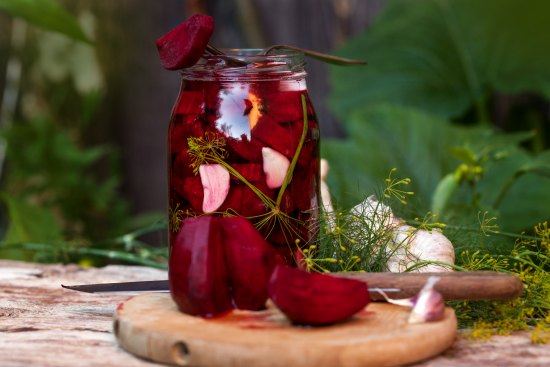One of our favorite things to eat in the winter is canned pickled beet! My kids love beets and this is a great way to save them for eating during those colder months.
Personally, I do not like beets, in general, but if I HAD to eat them to survive, I’d prefer the way my husband prepares them. Since so many do love beets and a good number of us do no, I hope this will help you to create some delicious food that can be consumed when it’s cooler outside while promoting health and wellness – whether you like it or not!

Beets are Chock Full of Nutrition
Beets, like the Cylindra Beet, are full of the immune-boosting nutrients like vitamin C, which will help your body fight off colds naturally, but that’s not all! They also contain a unique source of phytonutrients called betalains. Betanin and vulgaxanthin are the two best-studied betalains from beets, and both have been shown to provide antioxidant, anti-inflammatory, and detoxification support.
As well, beetroots contain valuable nutrients that may help lower your blood pressure, fight cancer and inflammation, boost your stamina, and support detoxification of the body. A quick dinner trick is to try adding beetroots raw to your salads or as part of your vegetable juice. Beet greens can also be used and don’t have to be used sparingly. Try sautéeing them with some spinach or Swiss chard to switch things up. You can also use them in cookies. Check out this recipe!
Canning Beets
The first vegetable of the harvest season to get canned is the dark red beets. While many people turn their noses at these vegetables (including me), they are becoming quite an en vogue trend in the food world. Praised for their nutritious qualities, but not loved for their flavor, they are at least a bit better when pickled. Gourmet jars at farmers’ markets and fine grocers are delicious, but can be pricey – yikes! So why not pickle your own? Very easy and simply perfect, these are great on any relish tray or added to your favorite salad!
Canning is all about prior planning and having items ready. Once you’re prepared, the process is extremely easy and fairly quick. In fact, my husband does all the beet preparations and cannon because I simply don’t care for thins, In a famine situation, I’m sure I’ll change my mind, but for now, this is for those who can tolerate the flavors of this hard to eat vegetable.
Please let us know what you think of this recipe! My kids enjoy it, but again, to each their own. OK, also, for the sake of complete disclosure, we have put chicken eggs in this and fully intend to put duck eggs in this year. Our ducks love to lay eggs and we do not waste food.
The Brine:
- 2 cups of water
- 2 cups of white vinegar (pickling vinegar) 5% acidity or more
- 2 cups of sugar
- 1 teaspoon salt
- fresh dill (whole sprigs straight from the garden)
To can:
- 3 1/2 pounds dark red beets (or any preferred variety)
- 1–2 large white onions (depending on preference, the amount of onion can be optional)
- 3 chicken eggs or 2 duck eggs (will update once our beets are ready for canning)
- fresh dill
- Start by washing the beets. If you are using homegrown beets, make sure to leave the root on and cut the leaves to within an inch of the beet.
- Place in a large kettle and cover with water. Bring to a boil and let cook until tender. They’re ready when a knife is easily inserted with just slight resistance. Since beets vary in size, they may take varying times to cook. Remove them individually as needed.
- When cooked, drain (remove from water), let cool, and remove skins using knife and gloves (if you desire) to prevent staining.
- Combine all the brine ingredients and let simmer on the stove.
- Slice the onions and place some in each sterilized jar. Add an egg (no shell) to each jar. Then fill with sliced beets. These can be sliced directly into the jars. If this is difficult, slice on a cutting board and pack jars.
- Top sliced beets with additional onions and eggs if necessary, leaving about a half-inch of headspace in the jar.
- Bring brine to a hard boil and fill each jar with the brine, leaving a half-inch of headspace.
- Clean the top of the jars with hot water to remove any debris and drips.
- Following the manufacturer’s directions, place lids and rings on jars, being careful not to over tighten (this can cause lids to buckle).
- Place prepared jars in boiling water bath, making sure water covers jars by at least one inch. Bring back to a boil and process for 10 minutes.
- Remove jars from kettle using a jar lifter and let cool completely before touching. Soon the lids should seal with a ping – music to a canner’s ears!

Look, this is still not delicious to me, personally, but one of the best ways to eat beats. I do like it when my husband adds fresh dill to his canned beat and eggs too. I have a hard time with beets and pickled eggs, but when done this way I actually like them enough that I will eat them.
That’s saying something, because normally (and you can ask Mr. Tipton) I would rather starve than eat something unappetizing. He says that’s “why you’re so skinny!” (I say it’s genetics, but you get the idea.)
source : Sara Tipton



